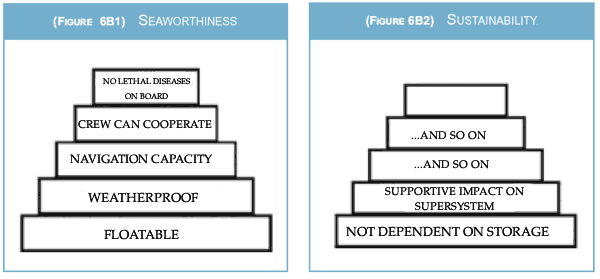
Modern agricultural is a device to convert large amounts of fossil fuel
into human food. It is therefore very vulnerable to energy scarcity and
supply disruption. Making it more sustainable requires nutrient recycling
and that people live near where their food is grown.
Sustainability is a multi-levelled quality in
which some of the constituent qualities are
more basic than others. If a basic quality is not
fulfilled, the fulfilment of less basic qualities is
not enough to bring sustainability about. To
explain, take the concept seaworthines, which is
also multi-levelled. The most basic need for the
seaworthiness of a ship is that it doesn't sink.
Next, it should withstand the weather at sea. If
it can't float, weather resistance is superfluous.
Next, navigation capacity is necessary, and so
on. All the new qualities need the more basic
ones to be fulfilled if they are to be of use.

The same goes for sustainability. Some qualities are basic, others are necessary but not basic. All the basic qualities must be fulfilled for a higher-level quality to have any effect.
Sustainability is also long-term. A hundred year sustainability is not worth the name.
Like many scientific theories, sustainability is easiest to test with the help of zero-hypotheses such as --'if this requirement is not fulfilled, is the system still sustainable?' If this approach is used, sustainability does not generally need to be defined but any factor can be tested for its effect on the general sustainability of the system. This method is used to identify the crucial factors for local sustainability in this study. Vulnerability could be said to be the inverse of sustainability. An effort to increase the sustainability of a system is often equivalent to reducing its vulnerability. One of the more basic requirements for a sustainable society is that it cannot be dependent on storage for its survival. If it is, its sustainability cannot last longer than the contents of the store.
Storage dependency is frequent in our society and a real threat to its sustainability. Two such dependencies will be discussed, dependency on stored energy, and dependency on stored nutrients, especially phosphorus.
All societies are dependent on agricultural production and today's agriculture is heavily dependent on fossil fuels. In developed countries, the input of fossil fuel energy to agriculture equals or surpasses the output of energy in the food supplied for human consumption (Hoffman, 1995). This is why industrial agriculture has been described as a black box for converting fossil fuel energy into edible food energy.
The implicit assumption underlying this conversion is that fossil fuel and the other necessary inputs will always be so cheap that they will not increase food prices beyond what the public can afford. This assumption can be questioned.
Energy prices are hard to calculate. The price for, say, gasoline at a filling station changes almost daily, as do the wages of many of those who buy it. Therefore, it is hard to say if the energy is 'cheap' or 'expensive'. One way to handle this problem is to calculate how long a time a person has to work in order to get a certain amount of energy.
The result of such a calculation is shown in
Figure 6B3, where the price for gasoline (in
SEK/kWh) in Sweden is divided by the salary
(in SEK/hour) of a 'general'worker.
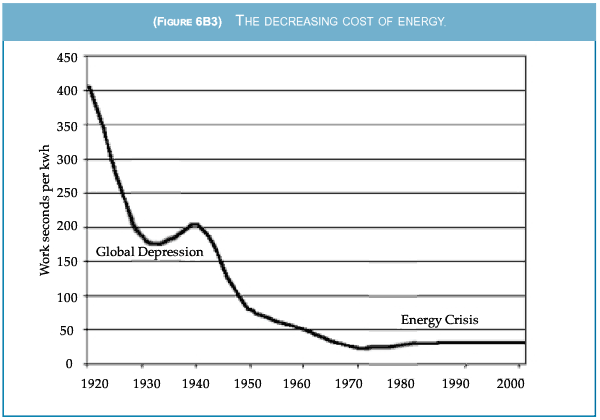 |
| The price of energy, in terms of the hours worked to earn KWH, has fallen to a tenth of its 1920 level. This means that the access to energy has increased tenfold. Note the events ('general depression, 'energy crisis') during energy price increases. |
This shows the availability of energy in the form of gasoline to the worker in hours/kWh. The working time needed to purchase one kWh of gasoline in 1995 has diminished to about 0.1 of the time needed about 1920, i.e., the availability has increased ten times.
As can be seen in figure 6B4, about half of the
world's reserves of crude oil have already been
used up (873 of 2027 GB in 2002 (ASPO
Newsletter 25, January 2003).
 |
| The 'Hubbert curve' displays the discoveries of crude oil during this century. They follow a bell-shaped figure with a peak around 1960. After that, no major fields were found. The total amount of extracted oil (the space under the curve 'Annual production') can never exceed the space under the Hubbert curve. If the time lag of the two curves holds, a peak production can be expected 2000 - 2005. (Adapted from Ivanhoe, 1995) |
The remaining reserves present two problems:
Calculations made from the verified crude oil reserves indicate that its availability will be of a relatively short duration, less than 50 years for conventional oil, about 60 years for all oil liquids, given the current rate of resource use today. As long ago as 1994, Masters published a review of global oil discoveries this century that showed a definite peak of discoveries around 1960 and a definite decline thereafter. Ivanhoe (1995) referred to the weighted average of the global oil discoveries, a typical bell-shaped curve, known as the Hubbert curve, after King Hubbert, who pioneered these calculations. The actual extraction of oil tends to follow a similar curve to that of the discoveries but with a lag of about 40 years.
These curves have recently attracted considerable
attention but among geologists and engineers
rather than economists. Different observers have produced different estimates of
the time of the peak (Figure 6B5).
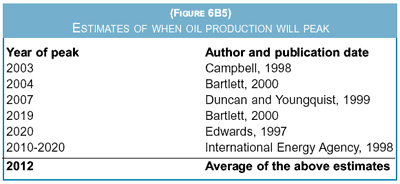 |
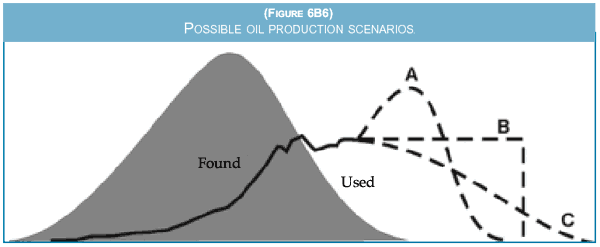 |
Since 'you cannot use oil that has not been found' the remainder of the extraction curve can take one of three principally different shapes (Figure 6B6):
A. An extraction increase, followed by a steep drop. This curve doesn't seem realistic, as only a few states (mainly Saudi Arabia, and to some extent Iran, Iraq, Kuwait, UAE, Venezuela and Nigeria) actually have the potential to increase extraction.
B. A constant extraction rate, followed by a production crash. This curve is unrealistic since YPE (energy yield per unit of energy) falls in ageing fields. However, a curve of this general type could be expected from efforts to prolong the plateau phase.
C. Dwindling production. This type seems to
be the most realistic.
 |
Since the world economy largely is powered by
easily accessed energy, a decrease in energy
availability might explain the recent global economic
slowdown. The curve in Figure 6B8 has
a relation to the curve in Figure 6B4 that does
not seem entirely accidental.
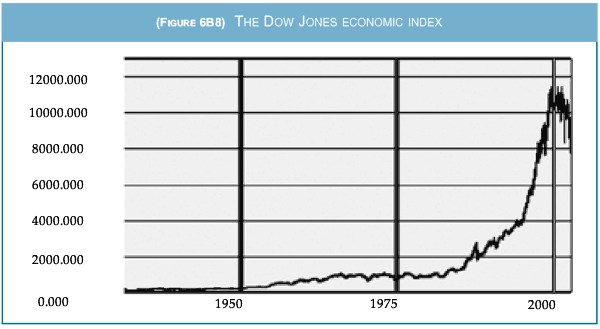 |
Prediction is very difficult, especially about the future - Niels Bohr
There is at least a theoretical possibility that in
some 15 or twenty years some deus-ex-machina
solution will provide the same amount of energy,
at the same price, as that which comes from
the extraction of fossil fuels today, although this
does not seem likely. Game theory provides a
way to evaluate different risk-possibility scenarios.
6B9 is a simplified game-theory analysis
of the energy depletion problem. It is
restricted to a 2 x 2 guess, cheap energy /
expensive energy, right / wrong. The result is
convincing enough.
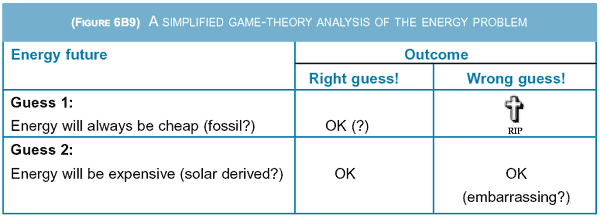
The elements that constitute terrestrial biological life can be divided into two groups, those that have gaseous phases (e.g. H, O, C, N and S) and those that don't (e.g. P, Na, K, Ca and so on). The fundamental difference between these two groups is that elements with gaseous phases can be distributed by air movements, but those without must be transported in liquid or solid form. The latter type of transportation is much slower, which is why such elements are prone to an uneven distribution and local deficiencies.
Nutrients are the small amounts of essential elements that constitute our bodies. Most of them occur in much higher concentrations in the earth's crust than in animal or plant bodies, so that deficiencies do not easily occur. There is one exception: phosphorus is about ten times more abundant in our bodies than in the earth's crust. This means that this element has to be concentrated from the surroundings. In water, phosphorus is available everywhere since the ions are transferred by the water itself. It is easy to find, even if the concentration is low. On land, however, the situation differs. Phosphorus has to be brought to where it is needed and any continuous leakage will be lethal. Recycling of phosphorus is thereore a typical quality of a mature ecosystem. A development period of about 400 million years of evolution has refined this capacity.
Since phosphorus is extremely important to the metabolism of biological systems (e.g. in DNA and ATP, both essential to biological functions), a lack of available phosphorus limits their capacity to use other resources, such as sun, water etc, even if they are available in profusion. Phosphorus cannot be substituted by the elements most like it, nitrogen and arsenic, which are above and below it in the periodic table; it cannot be replaced. It is not an exaggeration to claim that phosphorus is the most important nutrient.
The modern food system is not built upon the recycling of phosphorus as it loses them as the products leave the farm. A constant supply of phosphorus is therefore vital to farms that export more than they import (i.e. those specialized in plant production).
The price of phosphorus is today about 15 SEK/kg, and the price of the energy required for its extraction is about 3 SEK. As the richest deposits are exhausted, ores that require more energy for extraction will have to be used. If energy prices rise at 5% per year in real terms and the amount of energy required for extraction rises at 3% a year because of poorer ores, the mere energy cost for extraction would exceed 400 SEK/kg within 75 years, an increase of two powers of ten.
At the present energy price, phosphorus mining
might continue for around 130 years. Higher
energy prices will shorten this period. (Figure
6B10). This is clearly an unsustainable situation.
In other words, energy shortages will significantly
restrict the current method of phosphorus
use in our society.
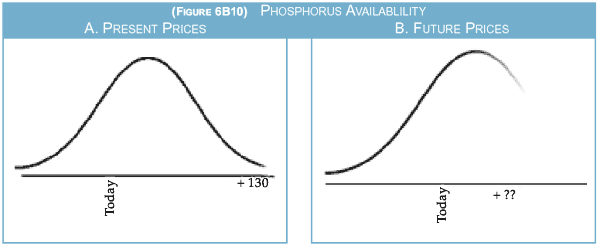 |
When farms become more specialised, agriculture usually becomes less diverse and develops an increasingly vulnerable structure. Half a century ago, it was common for farms to grow a large part of the feed for their animals and to keep a wide range of them. Cows, pigs, horses, geese and chicken could be found on the same farm, together with a variety of crops and refinement procedures. Today, this situation is very rare. Farmers are forced by the increased price for their inputs and the decreased price for their produce to specialise on products that can be produced in large quantities at a low unit cost. In such a situation, the importance of the distribution system increases. Transportation lines are longer, which increases vulnerability.
Moreover, the development of specialised breeds of animals and plants has generally increased the energy dependency of farms. Consider a 'wild' wheat plant. It has to carry out a substantial amount of work in order to flourish, grow, and maintain itself. What is left over of the collected solar energy is used to produce seeds. In modern agriculture, cultivars have been developed - to be lazy!
With the help of fossil fuels, the farmer carries
out a lot of the work that wild plant has to do
using solar energy. This enables more of the
solar energy collected by the 'improved' plants
to be transformed into seeds, although the
capacity of the improved plant to collect solar
energy has not been increased. (Figure 6B11)
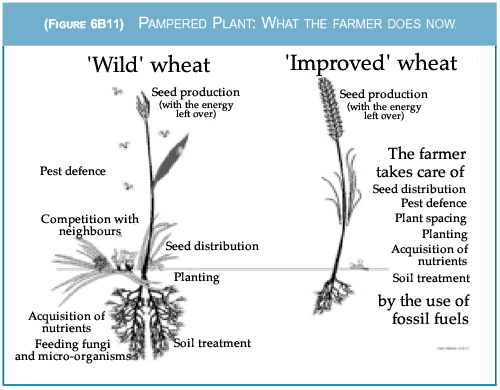 |
The same thing goes for domesticated breeds of animals. Modern agriculture therefore needs a secure and steady supply of cheap energy and a well-functioning transportation infrastructure. However, a large-scale system dependent on specialised units and a long-distance transportation system is not only more likely to fail compared to one with shorter transportation lines and more self-sufficient production units supplied with solar derived energy but the effects of failure will be more severe.
Consider an ordinary four-person family. If they live in a Swedish house constructed according to the Byggnorm 80 standard, their house will require around 17 000 kWh per year for heating and household machinery. Assume they want to reduce the energy requirements for their housing as much as possible. They exchange their house for a super-insulated one. By that, they can reduce the energy needed by about 8 000 kWh per year (The grey area in the left bar in Figure 6B12). Changing the car to one with the smallest fuel consumption available may result in a reduction of about 6 000 kWh, assuming they use it to the same extent (15 000 km/yr).
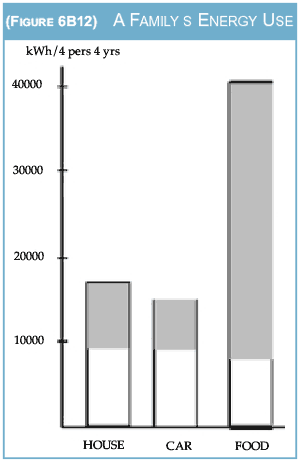 |
The food system is more complicated. A person always needs around 1 000 kWh per year, a figure that it is not possible to reduce by negotiations or increased efficiency. The energy needed for the four persons will therefore always be about 4 000 kWh. However, the energy conversion factor in the food system is about 0.1 (Hirst, 1974; Hall, 1992; Uhlin, 1996). This means that the energy requirements to feed these four persons is about 40 000 kWh! This is mainly because of the extensive transportation, handling and packaging of most foodstuffs. Even if the human body cannot be expected to increase its efficiency, the capacity of the food system to do so is huge:
What is generally called 'waste water' is often
a mixture of two different types, grey and
black. (Figure 6B13) Fairly clean rain water
run-off also gets into the waste stream in many
systems.
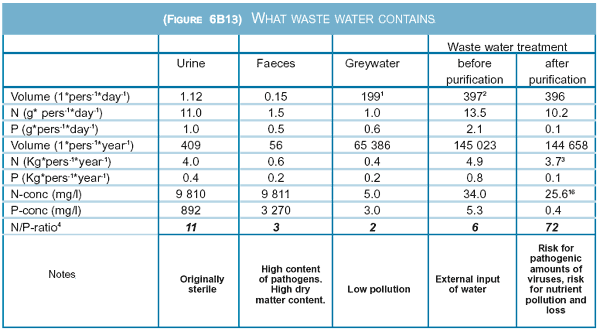 |
Grey water is the largest constituent of the waste water, about 65 cubic metres per person per year. This is the water from bathing, showering and washing. It is only lightly polluted and easy to purify locally. If unpolluted by toxic detergents, it is excellent for watering plants.
Black water is the toilet flush. It has a low volume, about 50 litres per day. This water contains human urine and faeces, about 1.5 litres in volume. Most of this water was originally drinking water. The urine contains most of the nutrients (67% of the phosphorus and about 90% of the nitrogen). If urine is mixed with water in the ratio of 1:12, you get the same nutrient concentration as used as the standard solution in plant growth research laboratories. Pathogens (organisms that may have the capacity to cause diseases) are only found in faeces, a comparatively small part of the total waste water volume, as they only amount to about 50 litres per person per year. Only 33% of the phosphorus and 10% of the nitrogen are found in faeces although the concentration is rather high. Mixing urine and faeces almost immediately creates a foul smell generated by the bacterial content of the faeces. We have an instinctive reaction against it. This is sound; it keeps us away from pathogens.
Current waste water management can be
described as the MIFSLA-method (MIx First
and Separate LAter), Figure 6B14.

The MIFSLA approach to waste water management may be described in the following way:
Hence, the actual function of the waste water treatment system turns out to be the removal of urine and faeces from the grey water, a job that can be more easily done by using source-separating toilets. To be fair, the development of this management method has historical roots and is not the result of a deliberate design. It has however severe consequences:
Thus, the current waste water treatment system severely restricts the possibility of nutrient recycling.
It is better to be prepared for a possibility and not have one than to have a possibility and not be prepared - Witney Young
How can the energy scarcity and phosphorus availability sustainability problems we have identified be solved?
Two routes can be followed to deal with energy scarcity - one can either attempt to find new energy sources or to limit energy demand. If the second route is chosen, one has to find a method that hurts as little as possible.
a. Finding new energy sources
There are certainly alternatives to liquid fuels but since liquid fuels are such an important part of our present energy system, bridging the gap between the depletion curve and that of increasing demand shown in figure 6B7 is a tremendous task. If the gap could be filled with electricity instead of liquids, it would require one new nuclear reactor to be opened every day! So the problem is not only to find a new energy source, but also to develop it fast enough. If you prefer wind to nuclear just multiply the number of reactors needed to fill the gap by about 1000 to get the number of wind turbines required. Moreover, the building of both wind turbines and nuclear plants requires the input of fossil fuels, given the methods used today.
It is theoretically possible to extract large amounts of energy from renewable sources, perhaps even as much as we use today, but this type of energy never will be as cheap as the energy we use today in terms of the time people have to work per kWh. This means that both the transition to renewables and general energy depletion will have profound effects on our society.
b. Increasing energy efficiency
It is often argued that the coming energy shortage could be met by increasing the efficiency with which energy is used. This seems convincing, since the gains in particular systems are often as large as 40-50%. The problem is that the pace at which machinery is changed is rather slow and the adjustment needs to be quick in order to deal with the depletion problem. Furthermore, increasing efficiency does not necessarily lead to an overall reduction in energy use. This was observed by the economist and mathematician Jevons in the 19th century in a study of increasing efficiency in coalpowered industries. Increasing efficiency, he found, only increased the number of industries using the new method (Jevons; 1990) and ultimately increased total energy use. This is referred to as the rebound effect.
c. Decreased access to energy
This is, perhaps, the most realistic scenario so we ought to prepare for it. If it is an overreaction, well, see Figure 6B9. According to the analysis referred to in Figure 6B12, the food system seems to be characterised by high energy use and high vulnerability to decreased energy access. Furthermore, a shortfall in the food system has worse effects than shortfalls in other domestic activities, except possibly water supply.
The most energy-demanding activities in the food system are (in no special order)
a. Agricultural inputs such as fertiliser
b. Agricultural traction - ploughing etc
c. Transport from farm to dinner table (farm - industry - retailer - shop - home)
d. Industrial processing (slaughterhouses, mills, industrial food processing, packaging)
Of these, c and d seem to be most easily reduced by changing societal systems while a and b could be cut by changing farm production methods. If it takes 1.04 units of energy as input to produce one unit of energy in food, b and c seem to account for a very large part of the total energy expenditure in the food system. Both c and d could be cut by shortening the distance, both geographically and systemically, between the farmer and the consumer. Agricultural traction, b, is a very large part of the agricultural energy use. Jansen (2000) however shows that energy crops converted to tractor fuel would use the same land area as the growing of feed for horses doing the same work. The difference is that tractors need an industry to be reproduced whereas horses are self-replicating and are therefore more suitable for an agriculture less vulnerable to changes in oil prices.
Because non-airborne nutrients are very precious, and molecules don't wear down, recycling such nutrients is the best way to maintain fertility and one used since terrestrial ecosystems developed about 400 million years ago. As our present waste management system does not allow efficient recycling, it is imperative for sustainability to change mainstream agriculture, the food system and the waste management system to make it so.
To become a sustainable settlement, nutrient recycling is just as important as becoming less dependent on fossil energy use. The whole society must be involved.
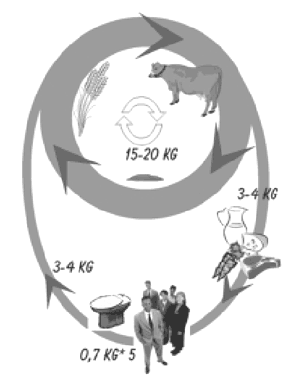 |
In pre-industrial times, almost all agriculture was based on the use of animal manure as a nutrient source for plant production to feed the animals. The number of animals kept depended on the farm's capacity to produce their food. This was a balanced agriculture. Today, though, agriculture has been split into animal husbandry and crop production. Animal feed has to be imported by farmers raising cattle and this gives rise to an excess of nutrients in farms specialising in animal husbandry and a lack of nutrients in farms where crop production is the speciality. In order to recycle nutrients, a balanced type of agriculture is necessary but this is not enough for complete nutrient recycling. The nutrients going to consumers must be recycled too. (Figure 6B15).
b. Nutrient recycling from human waste
Even a balanced agriculture loses nutrients, as it exports food for people. This amount can be estimated to 4-5 kg of phosphorus per hectare (Figure 6B15) This is rather little compared with the losses in specialised crop production, which is 15-20 kg of phosphorus per hectare. However, in the end, even this small quantity could lead to a phosphorus deficiency. Food production must therefore be balanced by a matching return of nutrients. Recycling nutrients from the population is not very complicated if the MIFSLA approach is avoided. A further benefit of avoiding this system is also that greywater is kept as clean as possible, which makes this water simple to purify and recycle locally. To mix all the nutrients with bacteria and large amounts of fairly clean water in order to pump it long distances and, after that to try to separate it in its original parts again is stupid from a sustainability perspective. It wastes valuable nutrients and energy simultaneously.
There are many different methods to correct this folly. The easiest way is to use some type of source-separating toilet. What the different types have in common is that they avoid the pollution of grey water, and that they make recycling of nutrients possible.
Many models exist today, with (wet type) and without (dry type) water flushing of faeces, with inside or outside emptying of faecal compost, or with vacuum systems.
The 'dry' type is the least resource demanding and easiest to install, but requires a cellar or some other space under the house. The 'wet' type is more expensive to install and manage but more like the current type of toilet system so 'toilet training' is not so necessary.
In an existing building, extensive alterations can be avoided by using either a dry type without a floor passage or a vacuum-type toilet.
The choice of type depends on one's individual preference and the type of house in which it is to be installed. It is most important to avoid the unnecessary pollution of greywater. Urine and faeces should be returned to the area of food production.
Unpolluted greywater can be use for watering a greenhouse or purified using simple biological methods such as the 'Wetpark' system used in Kalmar Technical High School or the 'Living Wall' system for confined areas. The management of the toilet system does not necessarily need to be the responsibility of the inhabitants of the house. It can also be done by an agreement with specialists or with the farmer.
How can the nutrients in the food be returned from the settlement to the farm? The local production and supply of food would permit the use of low-energy methods throughout the entire food system and minimise the effect of oil-price shocks. This raises the question: What is local? Naturally, that depends on the energy resources available. In a situation with an abundance of very cheap energy, 'local' could be within hundreds of miles. With expensive energy, 'local' could mean within sight. The closer production is, naturally, the less need there is for both transportation and industrial processing. 'Localisation' should therefore be adapted to the amount of energy expected to be available with due regard for the precautionary principle.
The sustainability problems around fossil energy dependence and the failure to recycle nutrients can be alleviated by the local production of food and the local recycling of nutrients supplemented by local water management including grey water recycling. Together these steps would improve the local economy and strengthen the local community but would require extensive changes to a lot of the existing infrastructure.
Even the most efficient transition to a source-separating toilet system and a well-organized return of nutrients to agricultural land would not create a nutrient cycle. Such a cycle also requires that local agricultural food production (from a balanced agriculture) fulfils a large part of the needs of the community. The psychological effects of local consumption and recycling may be quite large. Knowing where the nutrients are being returned to leads to a general sense of inclusiveness in the food system. A person involved in recycling them can point at a field and say: "My bread grows there".
In the localised system outlined here, the primary object of the farmer is to provide a local community (including himself) with food. Surpluses may be sold at the market but this is not the main goal of the agriculture which also involves the recycling of nutrients in manure and humanure and the production of feed for animals. Perhaps grey water recycling should be considered a farm activity too.
This is a much more diversified task than the
management of a farm is today. However, a
change to a more organic type of farming is
essential for sustainability in any case and since
off-farm intermediaries are largely excluded, it
might be more profitable (Figure 6B16) and
offer better prices to the consumer.
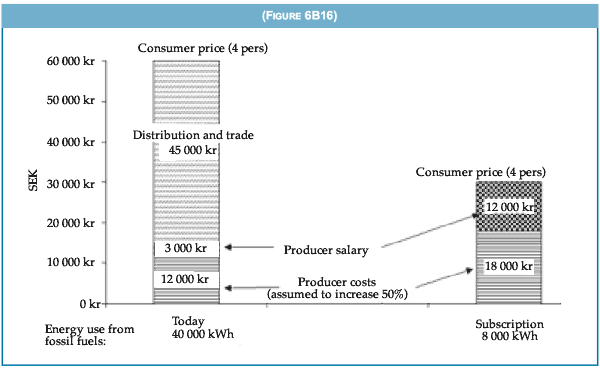 |
Since the food bought in a shop today is priced at about four times higher than the farmer receives, a group of consumers can easily offer him double the normal payment and still have a good deal. Even if the farmer has to invest 50% more to change from a mono-production system to poly-production, he will still have a large increase in salary. This is a win-win relation particularly as the energy cost/dependency decreases to about a quarter of its current level.
The implementation of these solutions is compatible with intermediate size settlements. Settlements with their associated farms can form groups of 800 - 1,200 persons and an associated agricultural area of 160 - 240 hectares. If areas also are used for the improvement of local ecosystems, 170 - 260 hectares can be expected to support these people. This population size is large enough for the establishment of a common social infrastructure, such as primary schools and small service business. However, it could be argued that this size of settlement is not enough for non-agricultural production, such as cultural needs and service provisions, and that this may generate an increased need for transportation. For the sake of discussion, however, imagine an area where such settlement types cover the land. In such an area, ignoring lakes, mountains etc., there would be a population density close to 500 people per square kilometer, which might be enough for a diversity of direct social interactions, although not the amount we are accustomed to in high density urban areas.
Nutrient circulation becomes increasingly expensive with increasing spatial distribution ranges (Günther, 1998). The energy requirements for distribution of food also tend to increase in quantum leaps when the distribution pathways require extensive packaging and preservation of the products. As pointed out earlier, solving these energy requirements by means of fossil fuels, increases the vulnerability of the society above the level required for human and environmental security. The only solution left compatible with such security would be to maintain basic energy flows from renewable sources, i.e. solar-derived, and to reduce the external energy requirements for all sectors to the lowest level possible.
The means of providing agriculture with its ultimate raw material, phosphorus, would also need to change. A system of linear flux of phosphorus through society over a prolonged time is both wasteful and insecure. Therefore, to attain nutrient circulation and at the same time reduce energy support requirements in large societies, a different societal structure should be chosen: the current trend towards increasing agricultural specialisation combined with urbanisation should be replaced by a closer integration of farms and settlements.
A name for such a strategy could be ruralisation,
as opposed to urbanisation. This development
strategy implies a successive replacement
of houses in need of extensive restoration or
rebuilding. Instead of building new houses in
existing urban areas, small settlements integrated
with agriculture as outlined above would be
created in the hinterland of the urban areas.
Many of the problems discussed above could be
alleviated by such a strategy.
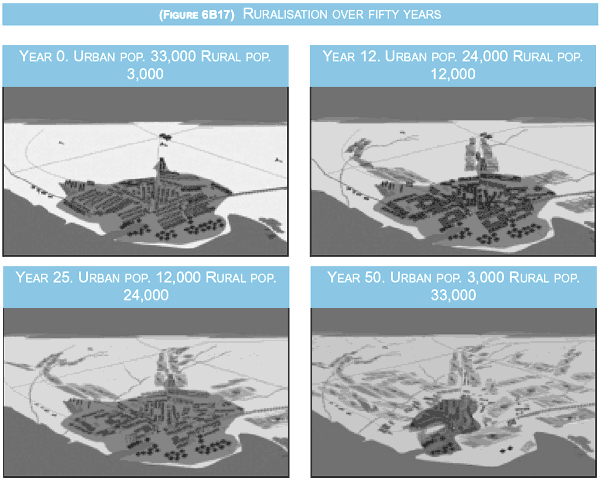 |
In this overview, I have argued that agriculture's structural problems cannot be alleviated by further changes along current lines because they reflect recent structural changes in society and must therefore be resolved by new structural solutions.
The problems include:
I have argued that these problems could be alleviated by 'ruralisation', a closer integration of agriculture and the places where people live. This would:
The economic and social benefits of this transformation are likely to be considerable, especially if fuel prices rise. The vulnerability of agriculture to energy supply disruption and nutrient loss would be greatly reduced. Indeed, it is hard to conceive of a sustainable society that is not principally powered by solar energy and which neglects to recycle those nutrients whose loss would reduce its carrying capacity.
Bartlett A. A., 2000, An analysis of US. and world oil production using Hubbert-style curves. Mathematical Geology, v. 32, no. 1, p. 1-17.
Campbell, C. J. 2003, ASPO Newsletter 25, January 2003.
Campbell, C. J., 1998, Running out of gas: The National Interest, Spring. p. 47-55.
Campbell, C.J., and Laherrere, J.H., 1998, The end of cheap oil. Scientific American, v. 278, no. 3, p. 78-83.
Duncan, R.C. and Youngquist, W, 1999, Encircling the peak of world oil production. Oil and Gas Journal, v. 8, no. 3, p.219232
Edwards, J. D., 1997. Crude oil and alternative energy production forecasts of the twenty-first century. The end of the hydrocarbon era: American Association of Petroleum Geologists Bulletin, v, 81, p, 1292-1305
Günther, F., 1997. Hampered Effluent Accumulation Processes: Phosphorus Management and Societal Structure. Ecological Economics, 21, 159-174. Elsevier
Hall, C.A.S., C.J. Cleveland & R. Kaufmann, 1992. Energy and Resource Quality. Wiley Interscience
Hirst, E., 1974. Food-related Energy Requirements, Science 184:134-38
Hoffman, R. 1995 Jordbrukets energibalans - En analys av energiflöden i Svenskt jordbruk 1993 och jämförelse med åren 1956 och 1972. KSLA Tidskrift nr 6: Lantbrukets energibalans - Energiflöden i Jord- och Skogsbruk. Sammanfattning från seminariunm 19/4 1995, Stockholm.
International Energy Agency. 1998, World energy prospect to 2020, Paper Prepared for the G8 energy ministers' meeting Moscow, 31 March-April 1.
Ivanhoe, L. F., 1995; Future world oil supplies: There is a finite limit; World Oil, October 1995, p. 77-88.
Jansén, J., 2000. Agriculture, Energy and Sustainability; Case studies of a local farming community in Sweden. Agraria 253 Dissertation. Swedish University of Agricultural Sciences.
Jevons, F., 1990. Greenhouse - A Paradox. Search 21 (5) p. 171-172
Magoon, The big rollover, http://geopubs.wr.usgs.gov/open-file/of00-320/of00-320.pdf
SNV 4425, 1995. Vad innehåller avlopp från hushåll? Swedish Environment Protection Agency.
Rapport. Naturvårdsverkets förlag.
Sundberg, K. Samhällstekniska avdelningen, Vattenskyddsenheten, SNV 1994-02-21 Fosforflödet vid A-anläggningarna 1992, baserade på miljörapporter för 1992. (The phosphorus flux at the A-plants, based on the environmental reports for 1992)
Uhlin, H-E, (1996): Energiflöden i livsmedelskedjan. SNV report 4732
Youngquist W., 1999, The post-petroleum paradigm and population. Population and Environment, v.20, no.4, p.297-315.
This is one of almost 50
chapters and articles in the 336-page large format book, Before the Wells
Run Dry. Copies of the book are available for £9.95 from Green Books.
